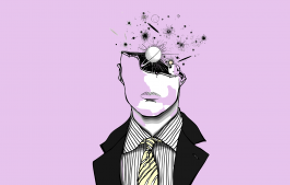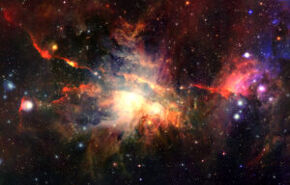Men are from Mars, and women are from Venus, so where are the rest of us from? Astrology, thankfully, embraces people of all sexual orientations and sexes and has assigned planets Uranus, Saturn, and Mercury to queer folk.
Astrological texts contain the wisdom of our forefathers, who accepted gender-fluidity and non-heterosexuality. There are many examples wherein these ancient societies celebrated and held the diversity of human experience in high esteem.
Astrological insights into sexuality
In modern times, when cisnormativity and heterosexuality are the norm, and gender-queer people are denied fundamental human rights (while homosexuality is deemed illegal in many countries across the world), it is of utmost importance to turn to the past and learn from our ancestors the value of co-existence, tolerance, and love that has enabled perpetuation of our civilization.
Phaldeepika, a scripture on Hindu astrology, has accorded masculine energy to the Sun, Mars, and Jupiter; femininity to the Moon, Venus, and Rahu; and gender-neutral qualities to planets Saturn, Mercury, and Ketu (south node of the moon). Moreover, Vedic astrology also considers three of the 27 nakshatras (constellations): Mrigashira, Moola, and Shatabhisha, eunuchs.
Mythological gender shifts
Saturn, the planet of Karmic justice, patience, and hard work, represents female eunuchs and transmen. Mercury, the benefic planet that acts as the intermediary between all sorts of dual forces, such as dark and light, moist and dry, and hot and cold, symbolizes male eunuchs and transwomen. In other words, Saturn is a “Female but acts like a man,” and Mercury is a “Male who acts like a woman.”
Mythologically, both Saturn and Mercury are gods. Legend has it that Saturn (Shani), a “lesbian,” married a woman named Sangya. However, Saturn, being a god, could change form according to will and occasion and conjure up male sex organs during intercourse.
Mercury (Budha) married Ila, the Indian androgyne god who was India’s forerunner of the Lunar Dynasty. Ila was born a woman but was later cursed that they’d have to switch genders every month. One theory states Mercury and Ila took turns being the wife or the husband in their marriage. Today, the transgender community in India lives on the fringes of society. Still, in Hinduism, even revered gods underwent gender transformation, lending legitimacy to transsexualism.
Exploring asexuality in astrology

Furthermore, astrology acknowledges asexuality or genderlessness. Ketu, the shadow planet of asceticism, non-attachment, and renunciation, embodies the asexual energy. The descending lunar node points towards celibacy sublimation of primal sexual instinct and the eventual spiritual awakening.
Notably, all three heavenly bodies are non-heterosexual. Mercury leans towards homosexuality, Saturn has a low libido due to physical deformity, and Ketu’s lack of desire for sex stems from the need for transcendence. In a natal chart, the presence of these planets in romantic houses or signs indicates the their being queer, asexual, or celibate.
Vedic astrology also suggests the idea that Mercury, which rules the realm of the mind, communication, and knowledge, stands for the artistic brilliance and creative intelligence that has come to signify a large chunk of the transgender population. Moreover, Mercury, the planet of perpetual youth, represents children and adolescents who have not yet attained sexual maturity. Saturn, the cold, old, dry planet of hardships, on the other hand, sometimes denotes impotence, old age, and an inability to procreate.
Western astrology’s gender-queer themes
Western astrology is likewise replete with gender-queer themes. Outer planets, namely Uranus, Neptune, and Pluto, are transcendental planets, which transcend the physical dimension in the Western tradition. Of them, both Pluto and Neptune emanate feminine energies. However, the magnificent Uranus is androgynous. The mythical tale states that Uranus’s son Cronus castrated Uranus while revolting against his regime and dumped the severed organ in the sea. Uranus thus lived as an androgyne after that. Uranus, the ruler of the sign of Aquarius, is known for its tendency for disruption, breaking away from traditional societal structures, and authentic expression.
Aquarius is a gender-neutral sign because of the rulership of Uranus. The myth of Ganymede solidifies its position as an androgynous sign. According to Greek mythology, the bisexual god Zeus had an affair with the beautiful boy Ganymede. (A Redditor served up the tea for us here.) Afterward, his jealous wife, Hera, took exception to their liaison. Zeus immortalized his young male lover by placing him in the sky as the constellation Aquarius. Consequently, the sign of the water bearer to date symbolizes homosexuality.
The Age of Aquarius and queer awakening
As per various sources, we have been transitioning into the Age of Aquarius for 50 years. During this time, we have seen the rise of feminism, occultism, the gay liberation movement, and the recent transgender revolution. All of these align with the Uranian spirit of freedom-seeking and rebellion. As we go deeper into the Age of Aquarius, we ought to become more in tune with Uranus’s need to express the repressed, challenge the status quo, and, ultimately, become aware of our higher selves. It should prepare us for Neptune’s celebration of our spiritual journey and Pluto’s promise of reincarnation and endless continuation of life.
Peter Clamp, in his article Astrology of Homophobia, writes that astrological symbols are universal, transgender is natural, and astrology “should not necessarily be solely aligned in human terms with physical men and women.” Indeed, there is a little bit of man in every woman and woman in every man and a whole lot of Universe within each of us.
Authored by Anusha Narain.
Related:
NASA’s Homophobic Telescope Was Just Launched Into Space
Space just got a little more depressing.
3 Reasons Why Queer People Can Still Celebrate the James Webb Telescope
Gays can have some deep space, as a treat.
The obscure queer history fact most people don’t know
Michael Venturiello of Christopher Street Tours does
Discover your cosmic identity and stay in the celestial loop when you subscribe to IntoMore’s newsletter!
Help make sure LGBTQ+ stories are being told...
We can't rely on mainstream media to tell our stories. That's why we don't lock our articles behind a paywall. Will you support our mission with a contribution today?
Cancel anytime · Proudly LGBTQ+ owned and operated
Read More in Culture
The Latest on INTO
Subscribe to get a twice-weekly dose of queer news, updates, and insights from the INTO team.
in Your Inbox

















